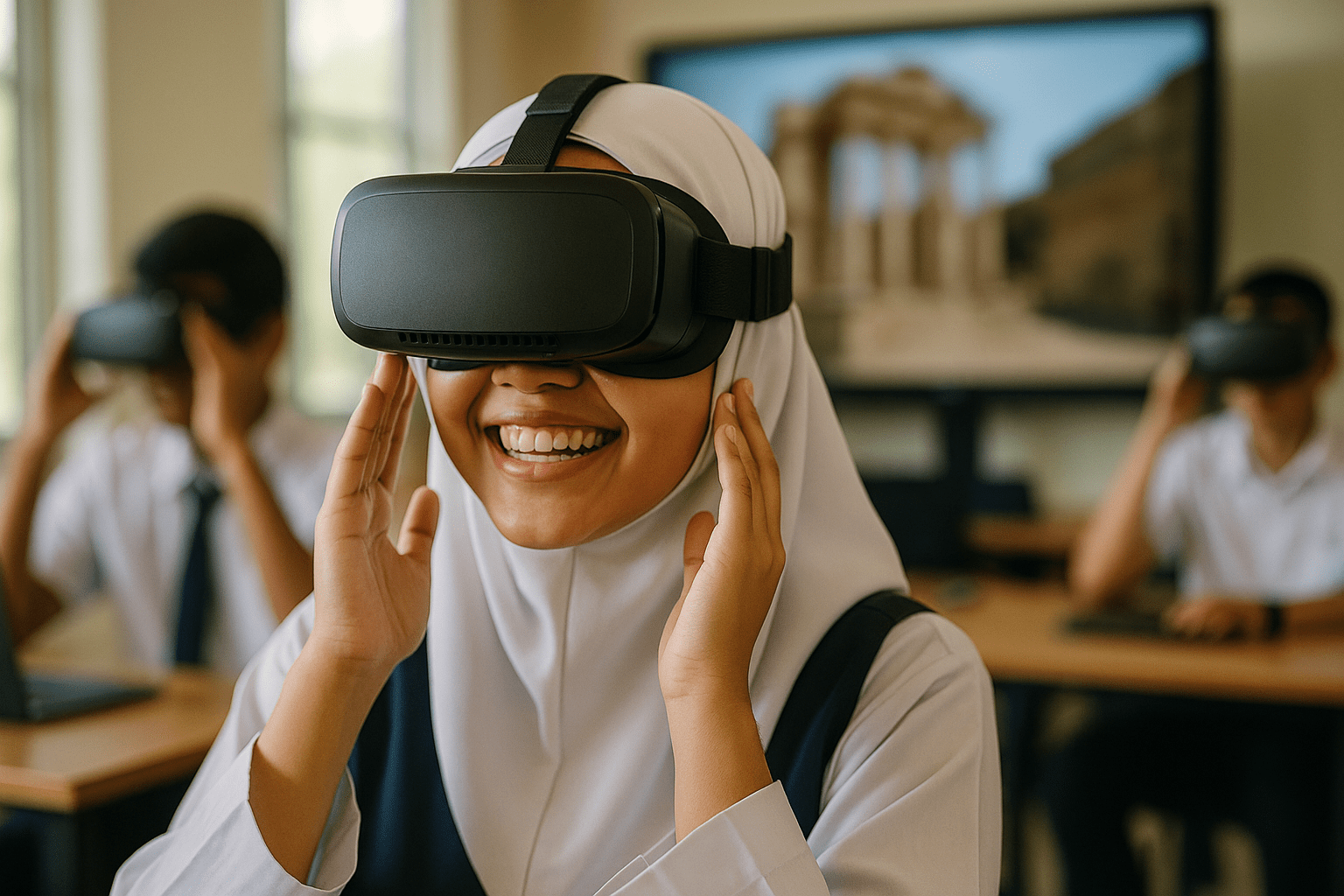How Virtual Reality in Education Is Reshaping the Learning Experience
Virtual reality in education isn’t about flashy gadgets or teaching students how to dodge flying dragons in 3D (well, unless you’re in a creative writing course). It’s about building dynamic, immersive learning environments-ones where students step into ancient Rome, perform virtual surgeries, or collaborate in a simulated physics lab from opposite ends of the globe. And yes, it’s already happening.
At Pukunui Sdn Bhd, we help educational institutions harness tools like the Moodle™ software and emerging technologies such as VR to level up their teaching and engagement. This post digs deep into the move toward virtual reality in education, and how schools, universities, and training providers can roll up their sleeves and use it-for real results. As educators seek innovative methods to captivate their students, the integration of virtual reality is becoming increasingly vital. By incorporating immersive learning through augmented reality, institutions can create interactive experiences that enhance understanding and retention. With these advanced tools, the potential for transformative educational experiences is limitless, fostering a more engaging and effective learning environment.
Why the Education Sector Is Turning to Virtual Reality
The appeal of VR in education is clear: it transforms passive content into active exploration. A student reading about marine biology is one thing. That same student walking on a virtual ocean floor to study coral systems? Unforgettable.
Here’s what’s accelerating VR adoption in learning environments:
- Increased availability of consumer-grade VR headsets
- Cloud-based platforms that support VR technologies remotely
- Educational content libraries offering prebuilt virtual reality learning modules
Still, access and training remain challenges in many places. But as early adopters are showing-those hurdles are manageable with the right approach. With a focus on innovative solutions, organizations are increasingly leveraging technology to bridge these gaps. In Malaysia, initiatives promoting lms training in malaysia have proven effective in enhancing digital literacy and workforce skillsets. By utilizing local resources and tailored programs, communities can cultivate a culture of continuous learning, ultimately overcoming the barriers that once seemed insurmountable.
The Impact of VR on Student Learning
Let’s not oversell it-VR isn’t magically turning every learner into a genius. But data emerging from pilot programs and studies is encouraging.
Here’s what virtual reality improves in actual classroom and training scenarios:
- Retention (improvement in memory recall in some studies)
- Engagement (students using virtual field trips report higher enjoyment)
- Confidence (especially in high-stakes scenarios like VR-based surgical training)
In short? The impact of virtual learning tools like VR isn’t hypothetical-it’s measurable.
Virtual Reality Applications in Education That Work
One of the benefits of VR in education is its flexibility. It can be used across fields, styles and formats. Here’s a breakdown of common applications:
1. Simulation-Based Learning
Best for technical, medical, or dangerous environments (like aviation). Students can repeat tasks inside a risk-free virtual environment until they’ve mastered them.
2. Immersive Storytelling
Language and history learners experience narratives instead of just reading them-think role-play in a Shakespearean theatre or walking the Berlin Wall.
3. Virtual Field Trips
Can’t take 30 teenagers to Machu Picchu? No problem. Use virtual tours to bring the world inside the lab or classroom. These are popular in K–12 settings globally.
4. Remote Science Labs
VR allows students to run timed experiments, mix chemicals, or dissect a frog, using interactive simulations rather than physical resources.
5. Special Education Programs
Virtual and augmented reality offer inclusive tools to support neurodiverse learners and those with mobility restrictions.
Using VR Headsets Effectively in the Learning Environment
Technology is only as good as its setup. Choosing the right VR headset depends on your institution’s size, infrastructure, and learning goals. Here’s a quick comparison of common options:
| Headset | Type | Best For | Approx. Cost (USD) |
|---|---|---|---|
| Meta Quest 2 | Standalone | General education use, VR field trips | $299 |
| HTC Vive | PC-tethered | STEM, medical simulations | $499+ |
| Google Cardboard | Mobile-based | Budget classrooms, introductory VR | $20–$30 |
Tip: When selecting hardware, consult with your IT team first. Wi-Fi access points and electrical layout can limit headset placement and concurrent usage. Little things like forgetting you only have three power outlets can kill the vibe fast.
Training Educators to Use Virtual and Augmented Reality in Class
Using VR as a flashy gimmick is one thing. Integrating it into teaching methodology? That takes proper training.
We suggest a three-phase model for upskilling staff:
- Orientation: What VR is and isn’t; managing expectations.
- Hands-on Training: Practice managing devices and platforms like Engage or Mozilla Hubs.
- Curriculum Mapping: Link VR software directly to learning outcomes.
Side note: One humanities faculty member was initially skeptical-until she designed a virtual reality field trip inside a Renaissance art museum and saw even her laziest student bring a notebook to class. True story.
Benefits of Virtual Reality Beyond the Classroom
VR provides benefits that ripple well beyond a single teaching session:
- Equity of access for rural or mobility-limited learners
- Cross-disciplinary collaboration between departments using shared VR spaces
- Scalable onboarding and simulations for staff training
And while VR may feel like a big investment, remember this: hardware costs go down, but skills and efficiencies compound over time.
How to Integrate VR Technologies with the Moodle™ Platform
For institutions already using the Moodle™ software, integration with VR content can be seamless with the right plugins and third-party tools. Some learning experience designers use content authoring tools like CenarioVR or ThingLink to embed VR learning objects directly into Moodle™ course structures.
You can also track student interaction metrics from within curriculum dashboards, helping staff assess the real impact of VR on skill development, participation, and student confidence.
Strategies to Launch a VR Program in Your Educational Setting
Implementing VR doesn’t have to be all-or-nothing. Start small, pilot intentionally, measure outcomes, and evolve your approach.
Start With These Eight Steps
- Appoint a VR implementation lead (IT + pedagogy background preferred)
- Audit your infrastructure (Wi-Fi, charging, physical space, etc.)
- Select content formats most relevant to your program (e.g., 360° video vs. full interactivity)
- Get educators involved early and let them co-design lesson plans
- Use curriculum-mapped outcomes to pick the right VR technologies
- Offer opt-in student training on device handling
- Monitor effectiveness with pre/post assessments
- Refine and expand iteratively each semester
The most successful learning institutions don’t throw VR at a wall and hope it sticks-they plan smart and scale sustainably.
FAQs About Virtual Reality in Education
How is virtual reality used in education?
Virtual reality is used in education to simulate real-life environments and scenarios, such as virtual field trips, laboratory experiments, or historical reenactments. It supports hands-on learning through immersive, 3D experiences that traditional classrooms can’t provide.
What is the mean benefit of using VR in teaching and learning?
The main benefit is increased engagement and memory retention. VR allows learners to explore situations in a first-person manner, normalizing complex concepts through interactive visuals and kinesthetic learning.
What is the role of virtual reality in enhancing students learning?
VR helps students learn by doing rather than just watching or listening. It creates emotionally engaging experiences that strengthen understanding, especially in subjects that benefit from visualization-like science, history, or medicine.
What is the virtual reality method of teaching?
The virtual reality method involves embedding VR simulations, virtual tours, or interactive 3D environments into the teaching process. These are used either as standalone modules or integrated into a broader LMS platform, such as the Moodle™ software implementation.
Looking Ahead: The Future of VR Used in Education
Virtual reality in education is fast becoming not just a nice-to-have, but a clear advantage. Led by forward-thinking institutions and dedicated educators, it supports new pedagogical models where learners interact with ideas instead of just memorizing them. This immersive experience fosters deeper understanding and engagement, allowing students to explore complex concepts in a more tangible way. Furthermore, the integration of mentorship in online learning enhances this experience by providing personalized guidance, enabling students to navigate their educational journeys effectively. As a result, learners are better equipped to apply their knowledge in real-world scenarios, bridging the gap between theory and practice.
At Pukunui Sdn Bhd, we help organisations and educational institutions integrate tech like Moodle™ and VR into real classrooms and training rooms. Whether you’re piloting your first virtual field trip or building a scalable simulation lab, we’re here to support the journey.
Ready to transform learning experiences at your institution? Contact us for a strategy consultation or to request a demo.

